Napanee Plain Natural Area
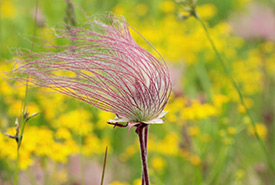
Prairie smoke, Camden Alvar East, ON (Photo by NCC)
Why this place is important
One of North America’s great limestone plain landscapes, the Napanee Plain is a rich complex of wetlands, forests, lakes, grasslands and alvars. Located 250 kilometres east of Toronto, and bordering on Kingston, this 178,000-hectare (440,000-acre) area is home to some of the rarest species in the province, including eastern loggerhead shrike.
Alvars are rare, naturally open habitats with either a thin covering of soil or no soil over a base of limestone or dolostone. It is a land of ecological extremes, where ground cover can be flooded in the spring, bone-dry in the summer and frozen solid in the winter. As a result, a unique and hardy collection of plants and animals live in these natural spaces. Alvars are found in only a handful of locations across the globe, including the eastern European Baltic region, the United Kingdom and Ireland. In North America, almost 75 per cent of alvars are in Ontario.
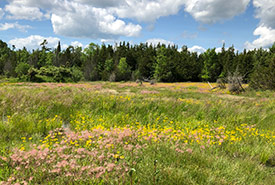
Camden Alvar East, ON (Photo by NCC)
Because of limited soil, fewer plants grow on alvars. This results in naturally open habitats that are perfect for grassland birds, including eastern loggerhead shrike. Because of its role in providing habiat for grassland birds, the area has been internationally recognized as part of the Napanee Limestone Plain Important Bird and Biodiversity Area.
The Napanee Plain is also home to many karst formations. These are rock formations including caves, sinkholes, enclosed depressions, dry valleys and gorges. Karsts provide extreme environmental conditions, meaning they are home to unique species and very fragile.
The Napanee Plain contains several major waterways, including the Salmon, Napanee and Moira rivers, and Millhaven Creek. These provide important travel corridors for wide-ranging species, such as bobcat.
What NCC is doing
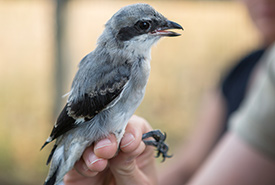
Tagging an eastern loggerhead shrike in the Napanee Plain, ON (Photo by Vincent Luk/Evermaven)
The Nature Conservancy of Canada (NCC) has been working with partners to conserve land on the Napanee Plain since the early 1990s. Today, we have helped to protect 1,414 hectares (3,495 acres) of the area’s significant natural features.
From 1993 to 2007, NCC acquired 730 hectares (1,800 acres) of wetland and other habitats, which would go on to become Menzel Centennial Provincial Park, and also helped expand nearby Stoco Fen Provincial Park.
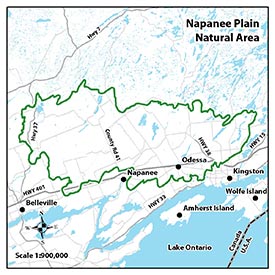
Click to display large map.
More recently, NCC has been working to protect land on the Camden East Alvar. This mix of open alvar, meadow, shrubland and wooded habitat is home to prairie smoke, the delicate early saxifrage, wild bergamot (the plant used to make Earl Grey tea) and several other rare native grasses, sedges, wildflowers and other plants. The open pavement areas give the impression of walking through a natural rock garden where you can spy interesting fossils dating back millions of years.
Protecting and enhancing habitat for grassland birds is one of NCC’s key priorities for the area – including at Camden East and at NCC’s Napanee Plain Alvar Nature Reserve, north of Napanee, where we have protected 121 hectares (300 acres) of habitat for these species.
Since 1970, North America has lost 2.9 billion birds. One of the worst-hit group of species is grassland birds. We have lost 720 million grassland birds since 1970 — that’s a 53 per cent decline. Three in four eastern meadowlarks are now gone.
Many grassland birds require open habitats of alvars, grasslands and meadows in order to survive — habitat types that have been lost to development and converted to other uses.
The eastern loggerhead shrike is one such bird. Also known as the butcher bird, this predatory songbird stalks its prey from above, swoops down and uses its strong, hooked beak to impale its meal on spikes or thorns, to devour later at its leisure.
While it might sound like something out of a nightmare, this bird is actually quite shy and elusive. And it is in grave danger. With less than 30 breeding pairs remaining in the wild, the eastern loggerhead shrike is one of the fastest-declining bird species in North America.
The migratory shrike is a classic example of an “area-sensitive species.” It requires large areas of open terrain before it is comfortable enough to nest. Few regular, protected nesting areas remain for the eastern loggerhead shrike.
At risk of disappearing in our lifetime, the endangered eastern loggerhead shrike relies open grassland habitat, like that which NCC is working to protect in the Napanee Plain.
For several years now, NCC and Wildlife Preservation Canada (WPC) have been working to increase the number of shrike nesting on NCC’s lands on the Napanee Plain. WPC has set up release cages on the Napanee Plain Alvar Nature Reserve, using it to release young captive-bred shrike into the wild. Each year the biologists in charge of the program see success, with birds returning to breed on alvars across southern Ontario.
What lives there
These are some of the significant and at-risk species found in this natural area:
Reptiles, amphibians and turtles
Mammals
Plants
|
Birds
|
Threats
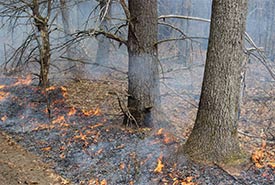
Prescribed burns on the Hazel Bird Nature Reserve are being used to restore native oak savannah and tall grass prairie. (Photo by NCC)
Historically, natural fires would have swept through the Napanee Plain, keeping trees and bushes at bay and maintaining the open grassland and alvar habit. Fire, as strange as it might sound, actually promotes biodiversity and leads to natural succession. However, decades of fire suppression has led to the encroachment of native and non-native brush or woody species taking over the plains.
In order to ensure that the grasslands and alvars of the Napanee Plain remain open, NCC staff and volunteers take part in an ongoing invasive and encroaching species management program. Each year invasive and native woody species that threaten to take over the open habitat are cut back. This on-the-ground-work mimics natural disturbance, such as fire, to keep the area open for the grassland birds. And it is working. Each year more and more birds come to nest on NCC’s protected lands.
Development and climate change also threaten this unique area. Habitat loss has led to the declining number of species on the Napanee Plain, especially grassland birds. Development reduces the connectivity of habitat patches through fragmentation and roads cause mortality in birds, reptiles, amphibians. But climate change is also threatening the landscape. Changes in precipitation patterns have let to reduced spring runoff volume, earlier and wintertime snowmelt runoff and lower than average water flow in the summer.
History
The Napanee Plain is the traditional territory of several Indigenous Peoples, including the Wendat, Anishnaabeg and Haudenosaunee Peoples. Settlement of the area began in the 1780s after the U.S. War of Independence. After the war, came the establishment of the Tyendinaga Mohawk Territory, part of Mohawk Nation. The Mohawks of the Bay of Quinte is a prosperous community working to protect the lands and waters here.
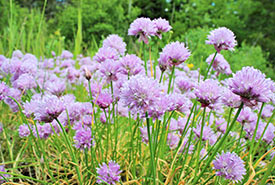
Chives, Camden Alvar East, ON (Photo by NCC)
Partners
The protection of the Napanee Plain is not something we can achieve on our own. Only through strong partnerships can this unique area continue to grow and thrive. NCC would like to thank the following partners for their generous support of our ongoing efforts in this natural area:
- Cataraqui River Conservation Authority
- Friends of Napanee River
- Friends of the Salmon River
- Friends of Wilton Creek Watershed
- Hastings-Prince Edward Land Trust
- Kingston Field Naturalists
- Land Conservancy for Kingston, Frontenac, Lennox & Addington
- Lennox and Addington Stewardship Council
- Ministry of Natural Resources and Forestry
- Mohawks of the Bay of Quinte
- Ontario Parks
- Queen’s University
- Quinte Conservation
- Quinte Field Naturalists
- Wildlife Preservation Canada
Current Projects
Click here to support conservation work in the Napanee Plain Natural Area.




